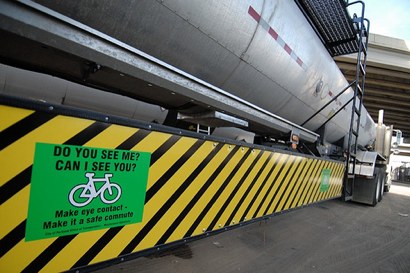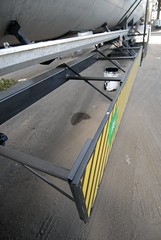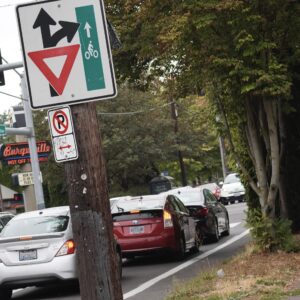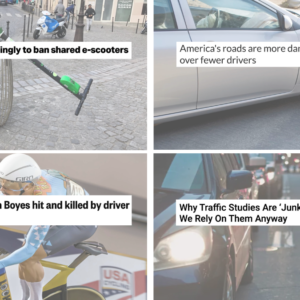
A bike safety initiative kicked off back in March within the City of Portland’s Bureau of Maintenance is starting to manifest on the streets.
While pedaling home the other day, I spotted a side underrun guard installed on a large tanker truck.
The guards are meant to help prevent someone on a bicycle from being swept beneath a truck in the event of a “right-hook” collision (there is no guard on the left-hand side). Safety is also improved by the bright yellow striping and green stickers (with white bike symbol) on the guards that reads, “Do you see me? Can I see you?”
These new underrun guards make good on a resolution passed by mayor-elect Sam Adams back in December in the wake of two fatal “right hook” crashes last year.







Thanks for reading.
BikePortland has served this community with independent community journalism since 2005. We rely on subscriptions from readers like you to survive. Your financial support is vital in keeping this valuable resource alive and well.
Please subscribe today to strengthen and expand our work.
Awesome. I had a chance to sit in one of the city maintenance trucks at Sunday Parkways and it was a great opportunity to see the perspective of the \’other side\’.
that\’s like the sweetest thing ever…ever! well okay, it\’s better than nothing, right?
pretty cool…kudos to the city for taking a proactive stance for the safety of others…
now if the city would require their contractors to do the same…
I\’ve never seen anything like it . Next step is to collect some effectiveness statistics on this…novel…invention.
I guess we\’ll need to wait for some right hook accidents to see if this invention reduces or mitigates injuries.
Oh, uh, I don\’t mean to sound negative. It *sounds* like a great idea. I just want the city to follow through with *measurement* to confirm its effectiveness.
jason..how do you suggest they measure \”effectiveness\”?
would you like to volunteer to be in the control group?
LOL. All of my smilies got eaten in the first reply. Lots of frowns and grimaces therein.
Basically, we\’re going to have to track any right cross incidents and assess whether or not this design made any difference in the nature of the accident, and what.
I don\’t think we will–well, I *hope* that we won\’t–have enough incidents to be able to establish any kind of effective control group 🙂
Side underrun protection is now required by law on all new trucks that operate in member states of the European Union, after research findings found it unequivocally did save lives.
Jason, I don\’t have the citation, but I seem to remember reading that the bashguards have reduced pedestrian and cyclist fatalities in the UK (they combine the 2 groups there) by about 40% in collisions with such trucks. I could be wrong about the exact number, however.
I believe PDOT\’s thought was that the UK\’s numbers were good enough for them to justify putting them on the city trucks. I am quite sure they will be tracking data and so we will have the first North American numbers. From a taxpayer\’s perspective, this does not seem like a radical idea to me.
If some North American trucking industry companies would voluntarily participate in this, we could have even better data. Too bad they\’ve been so resistant to such a common sense safety feature…
That seems like such a simple and effective measure.
Couldn\’t hurt to try.
It could probably make trucks more aerodynamic on the highway as well.
I want to move to Portland!
That is hot.
Kronda,
Cool that you got to sit in a maintenance truck. My hubby bike commutes and drives trucks/buses for his job. The visibility can be pretty crappy, especially right next to the truck. Good to know where the blind spots are.
I like the \”Can you see me, Can I see you\” sign. Good reminder about eye contact and visibility. It\’s great the city is trying something, even if it hasn\’t been \”proved\” yet.
I\’m skeptical. I think the money could be better spent on better bike facilities / training / etc. rather than weighing down trucks. In fact, why not have better regulations to keep trucks off city streets without certain permits of necessity and then limit their speed to 10mph within certain zones. I may be wrong but I doubt this is worth the bang for the bucks. I\’d also be curious about fuel economy issues… although, that will likely get me called out on a fuel vs. life comparison…
This kind of thing is standard in Japan.
I like this idea very much. It seems to accomplish three tasks. (1) it deals with the conflict between truck and bike, giving honor and credibility to the concerns that hare arisen as of late, (2) it provides a solution to be tried, and, most notably, (3) it has signage on it that also reminds the biker of the caution of which he or she must aware when biking in an urban setting.
I like that it points out how stupid it is to pull up beside a truck that is stopped at an intersection even if the law allows you to do so.
Makes for a nice handle we can grab onto when we get tired of peddling… 😉
Ummm .. one problem. The under run guard needs to run OUTBOARD of the wheels. That guard placement allows a cyclist/pedestrian/motor vehicle to get into the path of the rear wheels before stopping them from proceding further. In recent history in Toronto it has been the rear wheels rolling over the victim that caused the bulk of the trauma.
It also makes it safer for pedestrians and autos for that matter. All are less likely to be knocked over and pinned under a wheel, and the drivers are less likely to cut corners too tight.
Not really novel as note above. These have been in use in Europe for quite a while.
Thank you city for fitting out the fleet. Lets hope other cities, the state and the commercial truckers follow soon. No one likes to be involved in these crashes, including the drivers.
Well I\’ll be. An easy, logical, life-saving solution to something that has plagued cyclists (and motorists) for some time. I\’ve had friends driving the I-5 to California have logging trucks merge lanes right over their thankfully small cars, and that has got to be one of the scariest things to happen ever.
I\’m skeptical. I think the money could be better spent on better bike facilities / training / etc. rather than weighing down trucks. In fact, why not have better regulations to keep trucks off city streets without certain permits of necessity and then limit their speed to 10mph within certain zones.
As these bash guards also save pedestrian lives, what kind of training do you have in mind for them? For that matter, how does one target pedestrians for \”training\”? Regulations restricting truck speeds and when they can be on the roads are a fantastic idea. I wish you all the luck in the world convincing the trucking industry to support it and not spend 10x as much money opposing such ordinances as the actual cost of the bash guards themselves.
oh Donna…quit making sense and being so practical all the time. 🙂
it really doesn\’t fit the mold with most of this group here..
@ #14 : cement and garbage trucks are everywhere / anywhere. drivers need better training operating around cyclists, cyclists need better facilities that don\’t expose them to right (and left) hook hazards
Now if they can build one for cars.
You have to be kidding me. Depending on sideguards to keep cyclists out from under trucks is like depending on bear spray to be safe from bears. One should never pass a truck on the right, in the driver’s blind spot, going into an intersection. Right hooks are a combination of bad design and bad choices by the bicyclist.
The front of the truck is also a hazard to vulnerable road users. It is a shame that the side guards promoted by cities deliberately fail to protect cars and even exclude them from the definition of side underride, that is a lot of support for guards that could be available. Comments are now open for the NHTSA rear guard rulemaking and the side guard rulemaking will occur in a few months. http://www.underridenetwork.org/why-front-underride-or-underrun-is-important/ .
I’ve never understood why tiger striping is used so often to mark things you don’t want to hit.
The function of actual tiger stripes is to break up the outline of the cat to make them harder to see. I personally find it visually distracting and often think about that as I pass the supports that hold up some bridges over Columbia Blvd. Plain colors with some reflective accents strike me a much better way to go.
Contrasting colors I believe are meant to be a compromise between night-time and daytime effectiveness. We know from Canadian research that white tape alone is far more visible than the currently used red and white stipes. The red color is meant to give some contrast or visibility during daytime. Red is problematic at night as it offers poor candle-power unlike white or flourescent colors. There is also a problem of everything on the roadways being red which causes an effect called red-dot confusion, you can actually follow the red thinking you are in the wrong lane. Red at one time was considered a hazard color, it has long since been replaced by flourescent yellow-green and similar brighter and far more effective colors. Red and white tape was already used on a majority of trucks on the road so the Clinton Administration over our and Advocates for Safe Highways objections made red and white taope law for trucks, bad for safety but good for campaign donations. Bike riders need to understand color candle-power for clothing and reflectors etc., even light road film can decrease candle-power by 90%. Clean your reflectors for night riding, choose bright flourescent colors for reflective clothing. Tiger stripes equal old school, single color flourescents far more effective!
Useful but dated documents on conspicuity here:
https://underridenetwork.org/conspicuity